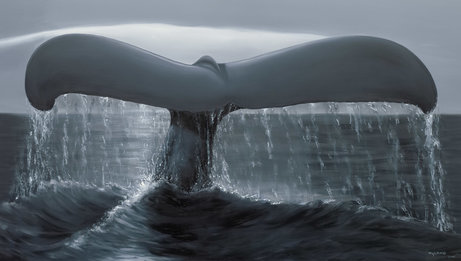Understanding Maui: Aftermath of Tragedy As information becomes more available about the Lahaina Fires, we look to understand the causes and implications of this terrible tragedy — and…
A study of the Baltic specimen offers new insights into what Europe’s climate was like some 35 million years ago.Eva-Maria Sadowski, a postdoctoral researcher at the Natural History Museum in Berlin, didn’t have a particular agenda in mind when she decided to borrow the biggest fossil flower preserved in amber ever found.“I did it without any expectations, I just did it because I was curious,” she said.Her curiosity pulled the thread of a more than 150-year-long case of mistaken identity, resulting in a clearer picture of what the Baltic amber forest of Northern Europe looked like more than 33 million years ago.The preserved flower bloomed about halfway between the extinction of the last non-bird dinosaurs and the evolution of humans, who found it in the 19th century in territory that is now part of Russia. In 1872, scientists classified it as Stewartia kowalewskii, an extinct flowering evergreen.The Baltic amber flower’s identity hadn’t been revised until Dr. Sadowski’s paper in Scientific Reports was published Thursday.Plants in amber are a rarity. Among Baltic amber specimens, only 1 percent to 3 percent of trapped organisms are botanical. This might result from a bias toward animals by amber collectors, but it also might be because animals wander into pools of sticky resin while plants have to accidentally fall in.While they’re harder to come by, plants in amber provide paleobotanists with a wealth of information, Dr. Sadowski said. Amber, which forms from tree resin, preserves ancient specimens in three dimensions, revealing “all the delicate features that you normally don’t get in other fossil types.”The flower that caught Dr. Sadowski’s eye was an inch wide — three times bigger than the next-largest blossom preserved in amber ever discovered. A colleague had told her of the flower’s “massive” size before she sought it out, and she wondered if he was exaggerating. He wasn’t. She then decided to see what 150 years of technological advances might be able to reveal about Stewartia kowalewskii.Once she had the fossil flower in hand, Dr. Sadowski polished the amber block with a damp leather cloth and toothpaste — a technique she picked up from her doctoral adviser, Alexander Schmidt, who learned some of his methods from a dentist. Under a powerful microscope, Dr. Sadowski saw perfectly preserved details of the flower’s anatomy, along with specks of pollen, which she used the pollen to see if the plant had been sorted into the correct family 150 years ago.A 19th-century illustration of a Symplocos plant, from “Flora Japonica, Sectio Prima,” by Philipp Franz von Siebold and Joseph Gerhard Zuccarini.The presence of Symplocos in the Baltics helps to show that ancient Europe was balmier than it has been for most of human history.Carola Radke/Museum für Naturkunde BerlinDr. Sadowski scraped grains from near the amber’s surface with a scalpel. “I only do that on a very quiet morning in my office, where no one disturbs me — you need steady hands, no shaking,” she said.After isolating and imaging the grains, her co-author on the study, Christa-Charlotte Hofmann at the University of Vienna, investigated the pollen, along with microscopic features of the flower’s anatomy. That pointed to an entirely different genus group than had been assigned in 1872: Symplocos, a genus of flowering shrubs and small trees not found in Europe today but widespread in modern East Asia.The redesignation of the giant flower helps to flesh out what scientists know about the ecological diversity of the Baltic amber forest. It also sheds light on how Earth’s climate has changed over the last 35 million-odd years: The presence of Symplocos helps to show that ancient Europe was balmier than it has been for most of human history.“These tiny grains are natural recorders of past climates and ecosystems that can help us measure how much our planet has changed in the past due to natural (nonhuman) causes,” said Regan Dunn, a paleobotanist at La Brea Tar Pits and Museum who was not involved with the research. “This allows us to better understand just how much our species is impacting the planet.”While “Jurassic Park” enthusiasts may be disappointed to learn that there’s no chance of getting DNA from the amber flower, George Poinar Jr., a scientist whose work inspired the series, said that there are bound to be more breakthroughs. In the nearly 50 years he’s been studying amber, advances in microscopy have made once-hidden details of ancient organisms dramatic and clear.“I think that’s fascinating, for people to see life like that,” he said.
In our household, items such as clothes and toys would have multiple lives before being thrown out, and leftover food would be transformed into tomorrow’s lunch. In other words, my mother was an early advocate of the circular economy, in which …
Credit: NASAAdvertisement CANADA Narwhals seem to be migrating later every year as ice-coverage patterns change in Arctic waters. The unicornlike whales were thought to be particularly vulnerable to climate change because of their 100-year life spans and slow evolution, so this behavioral shift bodes well for their adaptability. MALDIVES Researchers have identified a new type of ecosystem, which they have named the “trapping zone,” in the Indian Ocean. In it, swarms of tiny traveling animals get stuck among rocks and reefs, becoming easy prey for sharks and other large predators. PAPUA NEW GUINEA Scientists found evidence that a giant kangaroo species that walked on all fours lived in New Guinea until 20,000 years ago, thousands of years after most megafauna went extinct in neighboring Australia. The researchers suspect giant mammals lasted longer on the island because far fewer humans lived there. SAUDI ARABIA Drone footage suggests the Saudi government has begun constructing a city that officials have claimed will be 105 miles long and 0.1 mile wide—and enclosed within giant mirrors to blend with the landscape. The city is designed to be traversable by foot or rail, with a low carbon footprint. SPAIN Neandertal teeth recovered from Gabasa indicate these ancient human relatives were primarily carnivores. The teeth have low zinc 66, consistent with a meaty diet—which challenges prior work suggesting Neandertals were more omnivorous. ZAMBIA A study of chimpanzees at the Chimfunshi Wildlife Orphanage Trust shows the animals instinctively synchronize their steps when walking next to each other. This behavior is also seen in humans, suggesting that the unthinking coordination of basic motions is a shared ancestral trait. This article was originally published with the title “Quick Hits” in Scientific American 328, 1, 20 (January 2023)doi:10.1038/scientificamerican0123-20aABOUT THE AUTHOR(S)Daniel Leonard is a freelance science journalist and current Scientific American editorial intern whose work focuses on space, tech and natural history. Follow Leonard on Twitter @dalorleonRecent Articles by Daniel LeonardBacteria and Fungi Can ‘Walk’ across the Surface of Our TeethScience News Briefs from around the World: December 2022Ancient Sawfish Help to Illuminate Our Teeth’s Scaly Origins
The polar vortex is descending on the midsection of the United States, bringing bitterly cold Arctic air and causing temperatures to plunge rapidly in many areas. The deep freeze will be accompanied by …
An article in Beverage Industry reported that in 2020 sports drink sales in the U.S. alone were more than $7 billion. When you factor in that the major sports drink brands are sold in more than 80 countries worldwide, that equates to a lot of single-use plastic bottles that have the potential to end up in waterways and oceans.
When it comes to protecting our waterways and oceans, one of the worst things people can do is believe that their actions don’t matter. Sometimes, it’s easy to understand how people can feel this way when the problems we’re facing are so large, or seem so far away.






